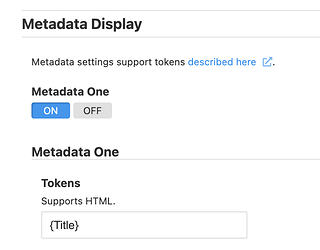Is there a way to have a separate photo caption from the meta description for a single image page? My captions are long and I don’t want them use for the meta description.
Is there a way I could insert content in the photo caption for a single page that uses the IPTC Accessibility field “Extended Description”?
I don’t see Extended Description mentioned in Metadata Tokens | Backlight, but it might work anyway.
If you use Metadata One in the Thumbnail Grid section, you can select your metadata field. In my case it is {Title}.
Then in your javascript code, you can access it with $photo->getMetadata('thumbnails_meta01'). If you use the metadata options of the Photo Presentation, the you access it as $photo->getMetadata('metadata_one').
Hope this works for you! Please keep me posted.
I tried picking up the text that’s in Extended Description. Perhaps I am doing it wrong by using {Extended Description} as the token in Metadata Slots?
Again, I am looking for a way to have a separate field for the tag <meta name="description"> and <figcaption>. The way it stands now, they both use what is found in LR’s “Caption”. SEO checkers balk at a longer <meta name="description"> saying it is too long, but based on my readings on the subject, there’s no penalty. Frankly, I think I can live with that because when I do use a longer <figcaption>, I get better SEO results even though the search engines want a shorter meta description. Plus, Google tends to use content from the first or second paragraph anyway.
Better SEO sounds like the way to go
Google only uses the meta desc for possibly displaying on the search engine results page (SERP). The max length is really just the limit of what might show on the SERP. Google may also ignore your meta description entirely. They might build their own by taking bits and pieces of text on the page. So it’s unknown what your meta description might do, if anything.
For my key articles that I am getting great ranking I’ll optimize the meta description. I also modify my WordPress to show that same text in my on-site searches. Otherwise WordPress just shows it’s own excerpt, which is just a truncated bit from the first part of the content. Still, after I see the SERP results I end up adjusting the meta desc in hope I can improve it. Again, it’s shooting in the dark really. There’s no penalty for wring anything, even something random like "Lorem ipsum dolor sit amet, consectetur adipiscing elit.
The actual “on-page” content is about all Google uses for ranking. The caption is part of that content. Content can be of just about any length. Lots of people claim “good” ranking requires 2000 words, but that’s not really true. Nice idea content length if your writing articles. But still, shorter articles can rank higher. Depends on the topic and how well the content is structured and written.
Ranking for a page that is pretty much just an image is different. They key ranking pieces are:
- page title
- image file name
- alt text for the image (most of the advice about this is misleading, it’s not about key words and not about writing complete sentences, it’s a short and concise description of the image, think like you were prompting some AI to create that image, such as “lake reflecting the sky in Patagonia Chile at sunset” and to test your alt-text use it in a image search and you should find image that are close matches to yours)
- content on the page, any content on the page is considered (this includes any figure captions, and Google also considers how close the text is to the other object, so the figure must very much describe the image, and not something like “we had a wonderful hike in the Patagonia and caught this fabulous photo”, see how that text really doesn’t tell us anything about the image? That text would be part of the content below the figure, but not the actual image caption)
